10 Best Internal Knowledge Base Software in 2026 (Free and Paid)

Creating a thriving internal knowledge base is a daunting task, but the right software makes it much easier.
That file you spent an afternoon digging through emails for—should have been part of your intranet, or the policies that you have to find every time when you hire someone.
In this guide, I’ll share 10 of the best internal knowledge base software tools (including free options) that I researched and tested.
Let’s dive in!
In This Guide
What Is an Internal Knowledge Base? And Its Use Cases
An internal knowledge base (IKB) is essentially an in-house library or information hub that only your team can access.
Companies use a internal knowledge base to store all their documents including policies, process docs, product FAQs, training guides, code snippets, or any resource employees might need on the job.
Unlike a public FAQ page for customers, an internal knowledge base is meant for employees, contractors, and internal stakeholders as a self-service resource.
Internal Knowledge Base Use Cases:
- Onboard new hires with HR and IT how-to guides
- Enable customer support reps with troubleshooting guides
- Provide engineers a central wiki for code standards
- Keep sales teams updated with current product details
- Offer everyone 24/7 access to shared knowledge
- Reduce repeated questions by enabling self-service
How We Researched and Picked These Tools

We rigorously test and research every product that we recommend through HeroThemes. Our review process. We may also earn a commission if you make a purchase through our links.
There are literally hundreds of knowledge base software out there, so choosing only 10 wasn’t an easy job as I thought.
With this guide my goal is to cover a diverse mix of internal knowledge base and knowledge management software, including free and premium options.
I evaluated each software based on my long 10 years of experience evaluating similar software.
And here are a few points that will help you understand more about my testing methods:
- Usability: If the team finds the interface clunky or the editor confusing, the tool won’t get used. The clean UI and features like WYSIWYG or Markdown editors are must have.
- Organization and Search: To make finding files easier, you want a robust search and logical structure (categories, tags).
- Features and Integrations: For an internal knowledge base, features like version history, access control, and integration with tools like Slack or ticketing systems are must have.
- Scalability: For example, some free plans limit content or users. We considered whether the free/community version could support a small team and how paid plans scale up.
- Value (Free vs Paid): Since budget is a factor for many, we intentionally included free and open-source knowledge base software alongside premium platforms.
In short, this list is a curated selection that balances functionality, user-friendliness, and cost.
Must-Have Features in Internal Knowledge Base Software
Whether you go with a free open-source wiki or a fancy enterprise platform, there are some core features you absolutely want in an internal knowledge base tool:
- Robust Search Functionality
- Easy Content Authoring (WYSIWYG Editor)
- Organization Structure (Categories/Tags)
- Access Controls and Security
- Version History and Editing Workflow
- Analytics and Feedback
- Integrations and Extensibility
- Customization and Branding
- AI and Modern Extras
I made sure that each of the tools listed in this guide provides the core features required for running an internal knowledge base, such as access control and a robust search function. While features like AI and customization are optional, they are still valuable.
Best Internal Knowledge Base Software (Free and Paid Options)
1. Heroic Knowledge Base

Heroic Knowledge Base (Heroic KB) is a premium solution for building a full-featured internal company knowledge base. It’s trusted by over 33,000+ businesses (as of writing this guide).
Heroic KB is designed to make creating a self-service hub easy if your company website runs on WordPress.
It offers a polished front-end for users and a straightforward backend for content managers.
Key Features:
- Instant AJAX Search to provide real-time search suggestions as users type. Kinda similar to Google’s autocomplete.
- Use of custom post types for articles and custom taxonomies for organization. You can create multi-level categories (and sub-categories) to neatly group your content.
- Article feedback and analytics to gain insight into how your knowledge base is working.
- Rich block editor. It uses a familiar WordPress editor (Gutenberg or Classic), so no learning curve if you know WordPress, or require little to no experience to get started.
- Access Control: Restrict the knowledge base to employees only with built-in features and proper integration with WordPress users and roles.
- Customization features to fit the knowledge base according to your brand style.
- Highly optimized for performance and scalability.
Pricing
Heroic KB is a paid internal knowledge base software. Licenses start at $67 per year for one site (includes support and updates).
My Take
Heroic KB offers a powerful yet user-friendly knowledge base tool. A perfect choice for beginners and professionals to create an internal knowledge base and get started as quickly as possible.
2. OpenKM (Community Edition)
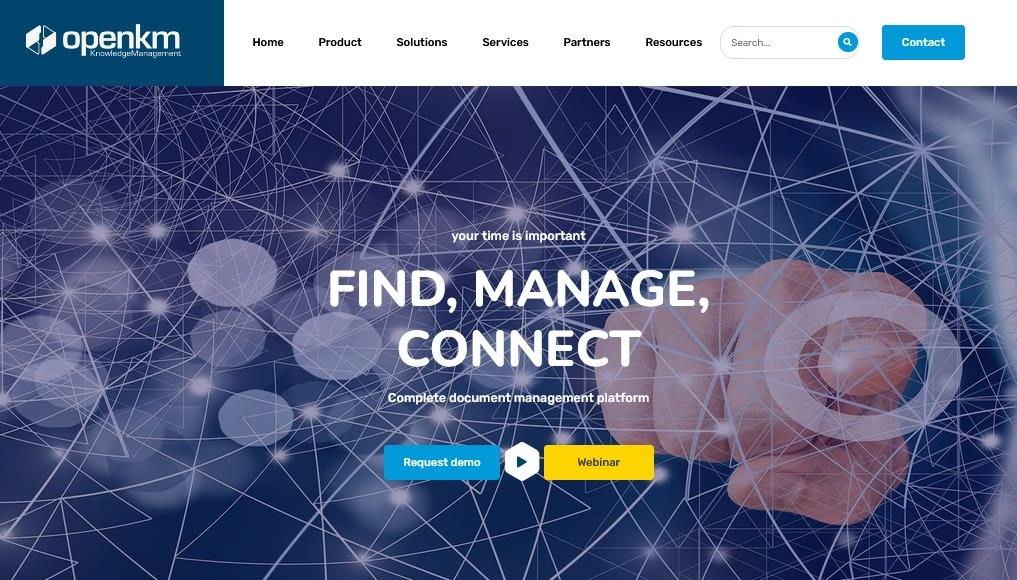
OpenKM is actually an open-source Document Management System (DMS), but it doubles as a robust internal knowledge repository.
Especially in companies that deal with a lot of formal documents, PDFs, and records.
The Community Edition of OpenKM is free to use (released under GNU GPL). It’s a heavier-duty solution intended for corporate environments where you might need workflows, audit trails, and a mix of file types in your knowledge base.
Key Features:
- Centralized Repository for All File Types: Word docs, PDFs, images, emails, you name it.
- Full-text search that looks inside PDFs and Word files
- Audit trail and versioning to Track every action: who viewed, edited, or moved a document
- Built-in approval workflows: draft a document, route it to a manager, then publish
- Email Integration: A nifty feature is OpenKM’s ability to archive emails directly into the knowledge base.
- Collaboration Tools: Ability to add comments and notes on documents.
- Ability to connect with tools like Trello or Jira through plugins
Pricing
Free for the Community Edition (self-hosted). You can download and install OpenKM Community without cost.
The company also offers Professional and Cloud editions with more features and official support, but those are paid (pricing on request).
My Take
OpenKM works well for large teams that need strong control and auditing. The setup takes time and technical skill, but once running the platform stays reliable. For small teams that want to build a simple internal wiki, the OpenKM feels overkill.
3. Documize (Community Edition)
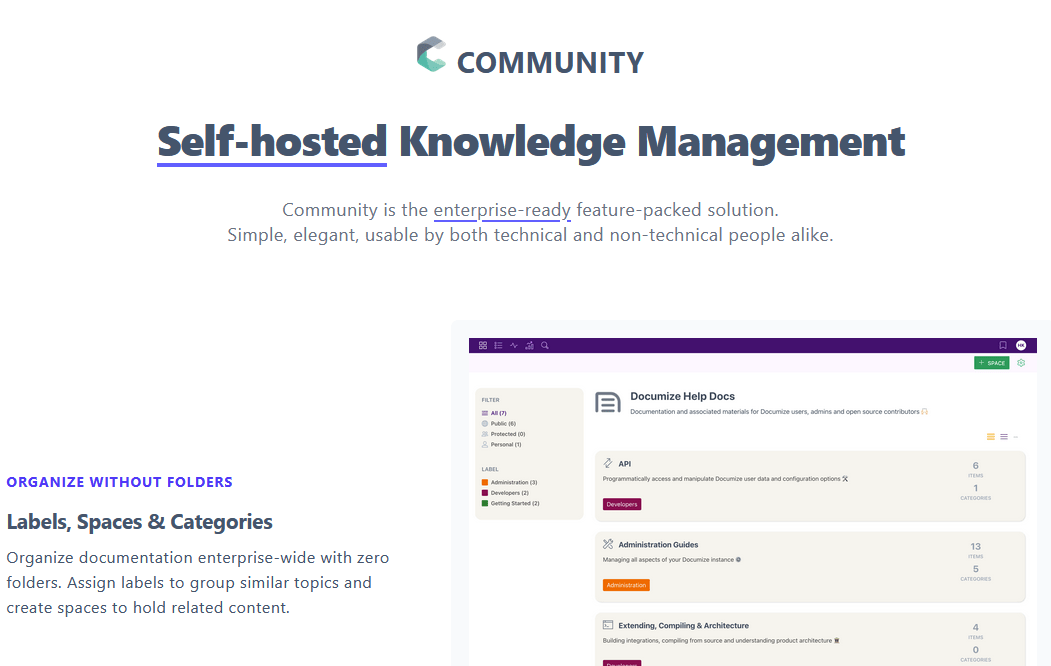
Documize is an open-source internal knowledge management platform. It’s like a hybrid between a wiki and a document collaboration tool.
Documize is often pitched as a Confluence alternative, bringing structured organization and robust permissions, but without any cost.
It’s written in Go with an Ember.js front end, and compiles into a single binary for easy installation—pretty neat technically.
Key Features:
- Organize content with Spaces (HR, Engineering, etc.) and categories or labels
- Powerful Permissions and Auth: Right out-of-the-box, Documize supports enterprise auth methods like LDAP, Active Directory, SSO (Keycloak, CAS).
- Ready-to-use templates for meeting notes, how-tos, and common documents
- Connect with Trello and Jira to embed boards or project data
- API for custom integrations
- Includes web-based editor with WYSIWYG and Markdown support.
- Lightweight and Cross-Platform: Runs on Linux, Windows, or Mac with MySQL, PostgreSQL, or MS SQL
- Community edition offers unlimited users at no cost
- Enterprise edition adds analytics, custom plugins, and support
Pricing
Documize is free for the Community Edition (self-hosted with unlimited users).
For the Enterprise Edition, which includes official support and extra features, they offer a free tier for up to five users. Beyond that, it is a paid service, with prices starting at around $900 per year for approximately 100 users.
My Take
Documize suits well for growing teams that need structure without paying enterprise prices. The platform is stable, supports serious permissions, and keeps content organized well.
4. Microsoft SharePoint

Microsoft SharePoint has been the granddaddy of internal knowledge portals for decades. It’s a web-based collaboration and document management platform included with Office 365 business plans.
SharePoint can serve as an internal company knowledge base or intranet, allowing you to create sites for different teams.
If your company is already in the Microsoft ecosystem, SharePoint might come “for free” as part of your subscription, making it a logical choice.
Key Features:
- Create sites for different departments (HR, IT, etc.) with multiple pages
- Document Libraries: You can have document libraries with versioning, check-in/check-out (to prevent edit conflicts), and metadata tagging.
- Enterprise grade search that looks inside documents and pages
- Set permissions using Active Directory groups for granular access control
- Save and edit Word/Excel files directly in SharePoint with Office Online
- Knowledge base templates
- Analytics: See how many people viewed a page or the trending content. However, it’s not as detailed as the analytics of a dedicated knowledge base.
Pricing
SharePoint Online is included in Office 365/Microsoft 365 Business and Enterprise plans.
For standalone, SharePoint Online Plan 1 is about $5/user/month and Plan 2 about $10/user/month, but most get it via the Office suite.
My Take
SharePoint can be a fantastic internal knowledge base or a frustrating maze, largely depending on how well it’s set up and maintained. If you already pay for Office 365, it can be a no-additional-cost solution.
5. Notion
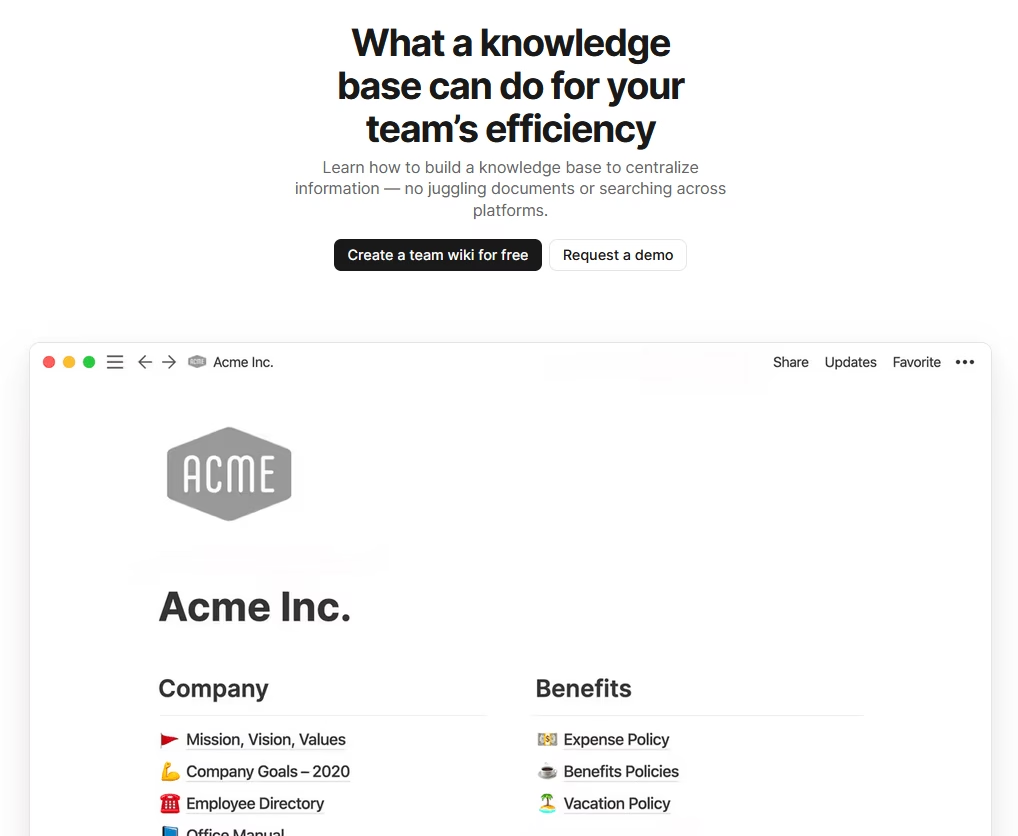
Notion is a popular all-in-one workspace app that’s great for creating internal wikis and knowledge bases, especially good for smaller teams or startups.
It offers a flexible pages-and-databases structure with a sleek editor that handles text, tables, kanban boards, you name it.
Many teams use Notion as an internal knowledge base, because it’s quick to set up and very intuitive. Basically a blend of docs and wiki with powerful organization.
Key Features:
- Rich Content Blocks: Build pages with drag-and-drop blocks like text, images, videos, code snippets, collapsible sections.
- Create hierarchy with pages and sub pages
- Fast search across all pages with filters
- Hundreds of custom templates for consistent formatting
- Collaboration and Comments
- Permissions to make pages private, or share with the whole workspace, or specific people/groups.
- Ability to embed content from Slack, GitHub, Google Sheets, and other services
- Work with Zapier or API for automation
Pricing
Notion has a Free plan that works for one user with unlimited pages, or it can be used by a small team with some limits.
Most teams opt for the Team plan at $10 per user/month (billed annually) which gives unlimited pages, version history, and unrestricted team collaboration.
My Take
Notion is one of my favorite tools for internal knowledge base (I used it a lot with my past company). It’s friendly, flexible, and fast to adopt.
6. Zoho Learn
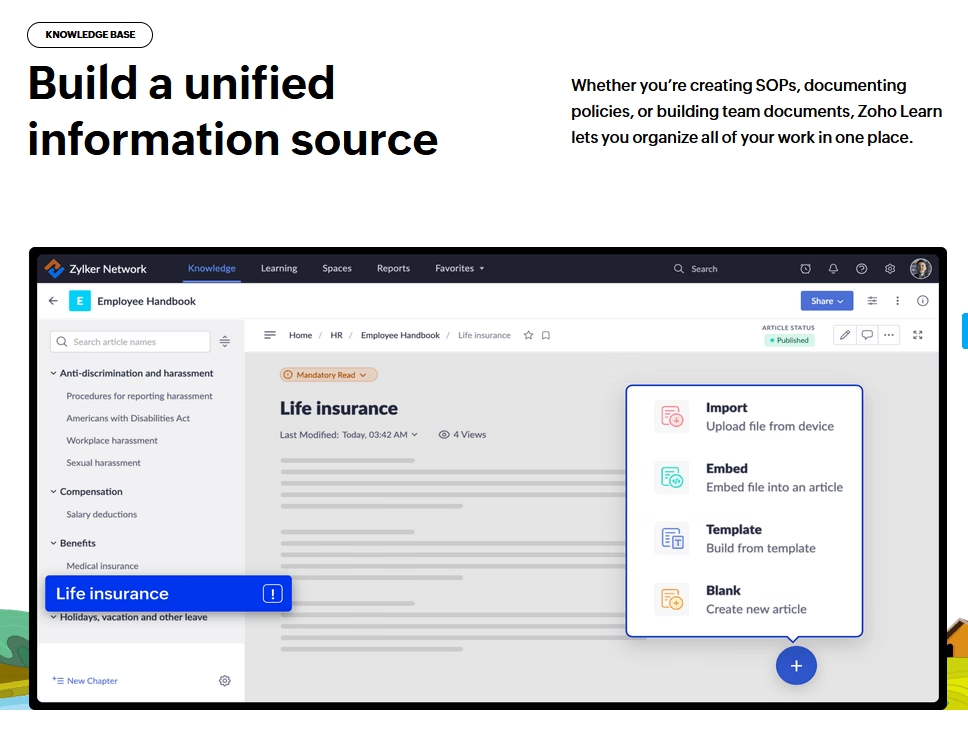
Zoho Learn is a relatively newer addition into Zoho suite, aimed at knowledge management and employee training.
It combines a knowledge base module and an LMS (Learning Management System).
With this you can create a company knowledge base (with manuals and articles) and also build training materials or quizzes.
Key Features:
- Organize content into Manuals (like books) with articles, chapters, and sections.
- Simple editor for articles with images, formatting, and reusable content snippets.
- Ability to import existing Word or HTML documents.
- Version history to tracks changes
- Global search across manuals and training materials, plus filtering options.
- Custom user portal for internal or external users
- Create training courses with lessons and quizzes
- Analytics to track course completion and user progress.
- Integrate with Zoho Desk
- AI assistant for auto-tagging content and search
Pricing
Zoho Learn offers a Free plan for up to 5 users which is nice for small teams to test it.
The paid plans are starting at ~$1/user/month—quite affordable.
My Take
Zoho Learn is a hidden gem for Small and Medium-sized Enterprise, especially those already using Zoho.
A standout is cost: at this price, it’s hard to beat the value of knowledge base + LMS.
7. Bloomfire

Bloomfire is a cloud-based knowledge management platform often used for internal knowledge bases. Especially in customer service and sales enablement contexts.
It’s known for its powerful search (even indexing video and slide content) and a Q&A style approach to capturing tacit knowledge.
Key Features:
- Intelligent Search (Even Video): AI-powered search indexes all content, including video transcripts and spoken words.
- Create posts as articles, documents, videos, or questions
- Organize content with custom topics (tags) and series (chapters)
- Collaboration and engagement features
- Analytics: Bloomfire offers solid analytics.
- Integrations and API: It integrates with common tools like Salesforce, Slack or Microsoft Teams.
- Security and Permissions: You can set up groups and control.
Pricing
Bloomfire is on the pricier side. They don’t publicly list prices (According to some sources, the price is around $25-$40 per user per month).
My Take
Bloomfire is for teams with heavy training content and large libraries. Its smart search and Q&A features are genuinely useful, though the price can be steep.
8. Confluence (Atlassian)

Atlassian Confluence, one of the most well-known internal wiki and knowledge base platforms. It’s very popular among software and product teams.
It provides a space-based wiki where teams can create pages, collaborate in real-time, and integrate with other Atlassian products like Jira.
Confluence has been around for a while, but the Cloud version has kept improving with features like collaborative editing and templates.
Key Features:
- Organize content into Spaces (mini-sites for teams or projects) with pages and sub-pages.
- Auto-generated page tree menu for easy navigation
- Flexible Content with Macros: You can insert macros (dynamic elements) such as tables of contents, info panels, statuses, embedded Jira issues.
- Code snippets with syntax highlighting for technical documentation.
- Real-time Collaboration: Multiple people can edit a Confluence page at the same time, with Google Docs-like indicators.
- Powerful search and labels (tags)
- Templates for runbooks and other standardized content.
- Templates for meeting notes, product requirements, troubleshooting articles.
- Set spaces or pages as viewable by specific groups or publicly.
- Ability to turn Jira tickets into knowledge articles.
- Integrate with Slack, Google docs and others.
Pricing
Confluence Cloud has a Free tier for up to 10 users, which includes 2 GB storage and some feature limits. That’s great for a small team or pilot.
For more users, Standard is about $5.42 per user/month and Premium is around $10/user/month (with advanced admin features and more storage).
My Take
Confluence is tried-and-true. It remains one of the best all-around internal knowledge base solutions—balancing features, cost (especially free tier), and integration capabilities.
9. Zendesk

Zendesk is well-known for its customer support software, but it also offers a robust knowledge base module.
Although Zendesk’s knowledge base is primarily designed for external self-service, its internal help center feature allows support agents (or any team) to use it as an internal knowledge base.
Key Features:
- Mark articles or sections as either internal-only (for staff) or external (for customers).
- AI-Powered Suggestions: Zendesk has an AI feature that recommends relevant knowledge articles to agents based on the context of a ticket.
- Creating articles is simple with a WYSIWYG editor (can also use Markdown).
- Organize content in a hierarchy of categories and sections.
- Customizable themes to brand your site.
- Search KB from the ticket view and insert articles into replies with one click.
- Flag articles as helpful or needing updates directly from tickets.
- Community Q&A forums for internal discussions.
- Version history to track changes
- Analytics show article views, search terms with no results, and tickets deflected.
Pricing
Zendesk knowledge base comes as a part of Zendesk Suite plans.
To have a knowledge base with Zendesk, you’ll need at least their Suite Team plan, which costs $55 per agent per month.
Kinda costly, but remember, but remember that it includes all the features required to run large customer service teams.
My Take
Zendesk is best suited for medium to large support teams that already use the platform to handle tickets. Its built-in knowledge tools boost response speed and ensure content is always up to date. However, the price may be too high for companies that only need a simple internal wiki.
10. BookStack (Open-Source Documentation Platform)
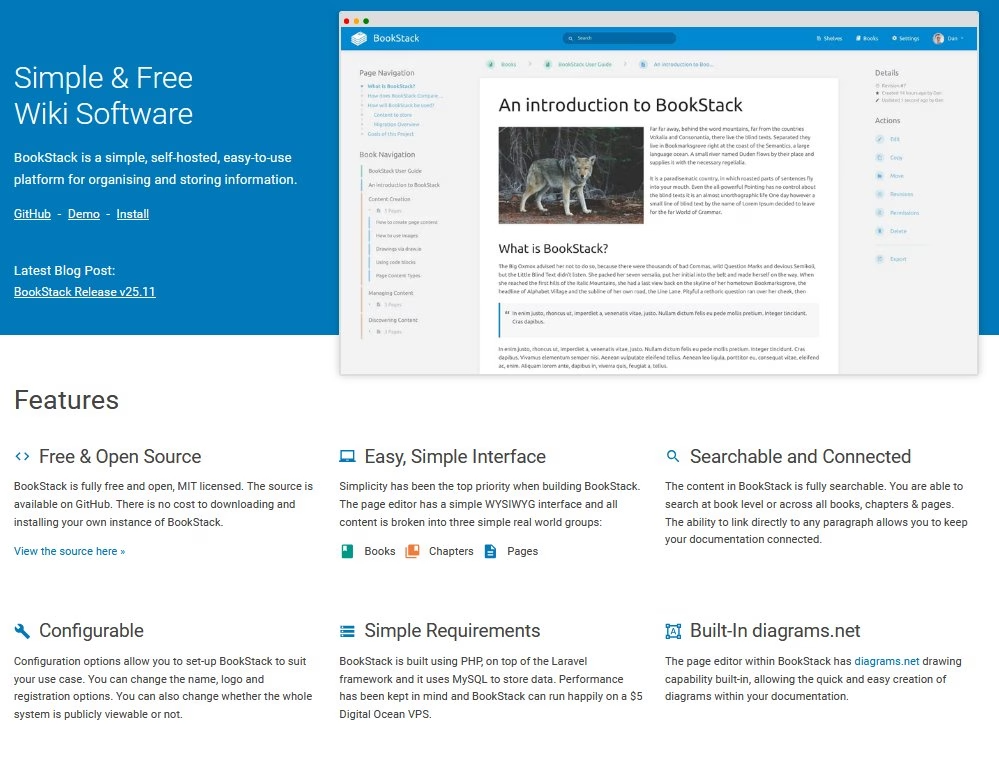
BookStack is a modern open-source knowledge base and documentation system.
It’s like a self-hosted alternative to Confluence or Wiki, but with a user-friendly interface out-of-the-box.
It’s written in PHP (Laravel) and is relatively easy to set up.
Key Features:
- Organize content into Books, Chapters, and Pages
- WYSIWYG editor with Markdown option for easy formatting
- Search bar searches all content across books, chapters, and pages.
- Sidebar menu, breadcrumbs for easy navigation.
- Roles and Permissions: BookStack has built-in role-based permissions. You can make content public or private. You can set roles (viewer, editor, admin, etc.) and even assign permissions per book or chapter if needed.
- Attach files to pages (PDFs or related documents)
- Page revision history and roll back feature
- Customization and extensions
Pricing
BookStack is free internal knowledge base software. It is open source and uses an MIT license.
My Take
One of BookStack’s goals is to be simple for non-technical users to create and manage documentation, making it a good choice for internal knowledge bases on a budget.
Final Thoughts and Tips
Choosing the “best” internal knowledge base software ultimately depends on your organization’s size, budget, and how you’ll use it.
A tool is only as effective as the knowledge culture in your company. Whichever software you pick:
- Invest time to organize it well
- Populate the initial content
- Encourage your team to use it and contribute
If you’re unsure which software to start with, check out Heroic Knowledge Base. It’s one of the most robust and affordable internal knowledge base solutions out there.
And remember, take advantage of free trials and freemium plans. Most of the software above lets you test them with your own content.
See you in the next guide!
Further Reading
How To Create a online Knowledge Base, Step-By-Step Guide
Integrating ChatGPT with Your Knowledge Base
13 Best Free WordPress Knowledge Base Plugins
Call Center Knowledge Base: Complete Guide
10 Best Free Knowledge Base Software (With Open-Source Options)
10 Knowledge Base Examples to Learn From



